The Best New York Style Pizza Dough and 14 Tips for Success!!
I’ve been making a lot of this NY style pizza dough recipe …. The obsession started a while back, and I’ve finally found a recipe that I love the best! After years of experiments (and I mean years!), I am now using this recipe based on recommendations from the many fine pizza makers at www.pizzamaking.com and the late great Dough Doctor, Tom Lehmann.

Making Pizza Dough at Home
Making NY style pizza dough is definitely somewhat of an art form. There are so many variables that can be changed aside from the ingredients alone. For example, these variables include:
- oven temperature
- temperature of the water used to make the dough
- proofing methods (room temp vs cold rise)
- order of adding the ingredients (yes, this makes a big difference!)
- mixing time
- use of autolyse
- use of poolish (I don’t do this or the one before, although I have in the past)
And then of course, the toppings which can be simple or as complex as you’d like. But don’t worry too much about all of this – my method is easy and straightforward. Plus, you will make better dough than 99% of the pizza chains out there. You will not want take out anymore!
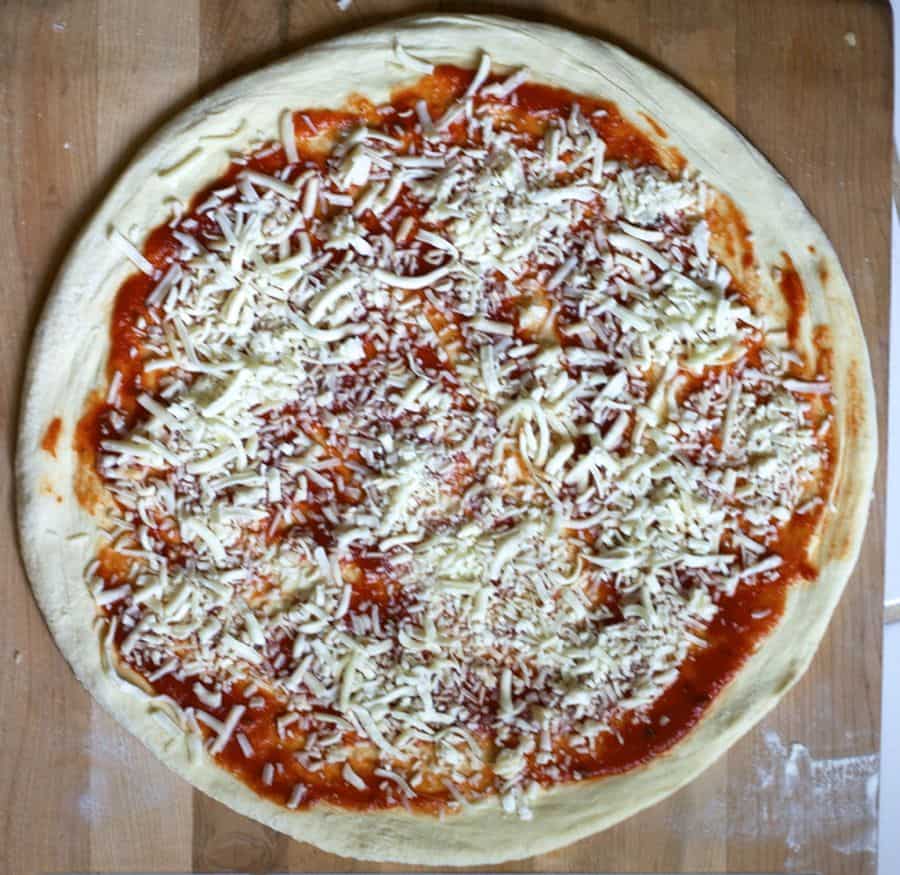
My Favorite Pizza Dough: The Big Secret (How You Proof the Dough)
My all-time favorite dough is NY style dough, which really is classic pizza dough that is stretched out into a thin crust pizza. This type of pizza dough contains water, flour, salt, instant yeast, and olive oil (and sugar especially when baking in a home oven, to help browning).
After it is mixed, it is proofed (left to rise/ferment) in the refrigerator for a minimum of 24 hours and up to 72 hours (it can also be frozen) – this is the big secret. I’ve used the dough up to 5 or 6 days afterwards, so you can essentially prepare dough for the week.
This recipe produces a crisp yet foldable crust that is tender, light, and flavorful and will make enough for four 14-inch pizzas. You can easily double or half the recipe to make 2 or 8 pizzas.
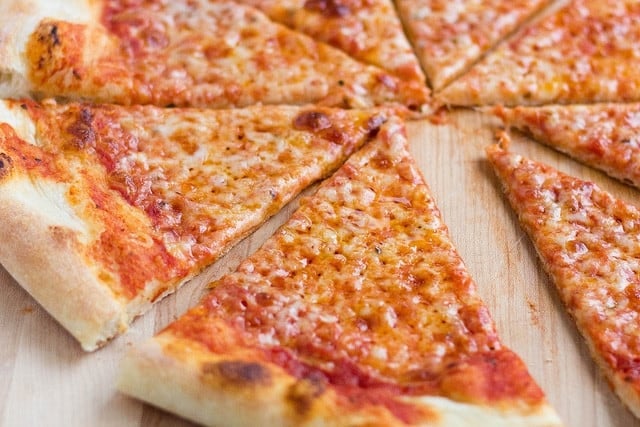
Fourteen Tips for Success
Tip 1: Choosing the flour
Use high-quality flour – I like to use King Arthur’s all purpose or bread flour; higher protein (ie, bread) flours work best. However, I prefer all-purpose flour because I like a lighter, airy crust.
Tip 2: Adding the yeast
Do not add instant dry yeast (IDY) directly to cold or cool water – you may shock the yeast (add the IDY to your flour instead) (please note that IDY differs from active dry yeast, which must be activated by adding it to water).
Tip 3: How much yeast?
Use only enough yeast to “get the job done” – yeast eats the sugar in your flour to produce its leavening effects – I find that if you use too much, your dough will be tasteless (this is just my opinion); however, it is a fact, that too much yeast can make your dough taste bad. Most recipes out there, some of them in well known, published books contain too much yeast!
Tip 4: Cold ferment that pizza dough!
Always use your refrigerator. The best NY style doughs “ferment” or “cure” in the refrigerator for at least 24 hours and up to 48 72 hours. This is called a “cold rise” (vs warm rise on your kitchen counter).
The refrigerator is used to retard (or slow) the dough’s fermentation, allowing that distinctive flavor to come through (ever wonder why some pizza crust tastes different than others, despite the fact that they are both made from just about the same exact ingredients? – this is a big reason why!)
When your dough rises too quickly, the flavor will not develop optimally. Slow rise = MUCH better flavor.
Tip 5: Weigh those ingredients!
Use a scale to weigh the flour instead of using a measuring cup – it is much more accurate and will yield superior results. I’ll admit, I resisted doing this for a loooong time. Just do it. You’ll be glad you did and your dough will be more consistent and much improved.
Tip 6: Add oil last
Mix the oil in as the last step, after the flour has all been incorporated. This is important to allow the flour to hydrate properly.
Tip 7: Flour your dough balls
Before tossing or opening your dough balls, flour them *very* well on each side (if you are a beginner) to ensure they do not stick to your counter or pizza peel. I sometimes use a bit more flour after I begin spreading them.
Tip 8: Keeping those rims a bit puffy
Take care not to “degas” the rim of your pizza as you are spreading your dough! Do NOT ever use a rolling pin! There are many different methods to spread/open your dough ball. I hope to add a few pictures someday of this process.
Tip 9: Baking pizza in a home oven
Ensure that your oven is preheated for a sufficient amount of time (about 1 hour) and bake the pizza within 6 to 8 inches of the top of your oven (ie, your broiler) so that the tops browns sufficiently in conjunction with the bottom of the pizza.
Do not place the stone near the bottom of your oven. I made this mistake for too many years.
After your stone has been preheated sufficiently, the heat from the stone will cook the pizza from the bottom and you can switch the broiler on if you find you need more browning on the top (I now use the broiler to bake my pizzas…more on this sometime in the future).
If you find that your cheese is browning well before your rim attains sufficient color, use partially frozen cheese (ie, place shredded cheese in the freezer while the oven is heating up) and cold sauce or you can drizzle just a bit of olive oil on top of cheese.
Tip 10: Use a pizza stone or steel
Use a pizza stone if you have one. The stone with draw moisture out of the dough and produce a beautifully crisp crust. I use a pizza steel because my stones kept breaking.
Tip 11: Use just the right amount of sauce
Do not use too much pizza sauce – it will make your pizza soggy
Tip 12: Find the right kind of cheese
Do not use low fat cheese to top your pizza or pre-shredded cheese (the former will not melt sufficiently and the latter contains additives that prevent the cheese from sticking together and therefore does not melt very well). The best is low-moisture, whole milk mozzarella.
If you must use pre-shredded cheese, I’ve found that adding the sauce on top of the cheese helps with the melting. Also, do not use too much cheese; apply it sparingly so that you can achieve that mottled NY pizza appearance.
Tip 13: Flour your pizza peel
Use semolina or flour on the bottom of your pizza peel to prevent the pizza dough from sticking but be careful not to overdo it because it will burn.
Tip 14: Learn to launch that pizza
Give the pizza peel a few very small quick jerks to make sure the pizza will easily slide off your pizza peel before attempting to transfer pizza to the oven, and more importantly, rub flour into the peel before placing the dough on top.
Essential Equipment
Please note that as an Amazon affiliate, we earn a small commission if you purchase a product at no additional cost to you.
I adore my baking steel; it’s transformed my home pizzas into restaurant-quality and better. You will love this! A kitchen scale streamlines measurement with remarkable accuracy, while a pizza peel is essential for smoothly sliding pizzas into the oven. And proofing boxes provide an optimal storage for pizza dough fermentation, enhancing flavor, texture, and elasticity.
Please visit our SHOP page for more recommended tools and equipment to make restaurant-style NY-style pizza at home!
How to Stretch the Pizza Dough
A nice video (from The GoodFellas Pizza School of NY), showing how to stretch the dough:

How to Freeze Homemade Pizza Dough
- After mixing dough and dividing into balls, place dough in refrigerator for at least 24 hours.
- Place dough balls on baking sheet lined with plastic wrap or parchment paper, cover loosely with plastic wrap and freeze until firm (~ 2 to 3 hours or up to overnight).
- Wrap frozen dough balls individually in plastic and store in zipper-lock bags for up to 4 weeks.
- When ready to bake, transfer unwrapped dough into the refrigerator for 12 to 24 hours before making pizza.
- Bring dough to room temperature for 20 to 60 minutes before baking (less time for hot kitchen/summer and more time for cool kitchen)
Pizza Dough Calculator
Need more dough? Less dough? Try out our new Pizza Dough Calculator to calculate the weights to get it just right!
Have More Questions?
Please See My NY Pizza FAQ
If you tried this recipe, please leave a 🌟 star rating and let me know how it went in the 📝 comments below! SUBSCRIBE for more recipes.
📖 Recipe

The Best New York Style Pizza Dough
Equipment
- pizza stone or pizza steel for baking
- Standing mixer optional or hand knead
- kitchen scale highly recommended instead of volume measures
Ingredients
Original Recipe for Four 14-Inch Pizzas; want to make more or less? Use the pizza dough calculator
- 6.5 cups (796 g) all purpose flour or bread flour (weighing is most accurate!)
- 2 1/4 cups (493 g) water barely cold water (17.4 oz per 2 1/4 cups)
- 1 teaspoon (3.5 g) instant dry yeast
- 2.5 teaspoons (15.6 g) salt
- 2 teaspoons (7.8 g) sugar
- 1 tablespoon (11.8 g) olive oil
1 Pound of Dough (~454 grams) (use the pizza dough calculator to make more or less dough)
- 2 1/4 cups (274.5 g) all purpose flour or bread flour
- 3/4 cup (170.2 g) water
- 1/2 teaspoon instant dry yeast
- 1 teaspoon salt
- 3/4 teaspoon sugar
- 1 teaspoon olive oil
Instructions
Mixing the Dough
- Place water in mixing bowl.
- In a separate bowl, mix salt and yeast (and sugar if using) into flour
- Combine flour/salt/yeast mixture into water and mix until all the flour has been incorporated.
- After flour has been totally incorporated, add oil and knead for about 4 to 5 minutes (see note)
- Test final dough temperature, which should ideally be between high 70s to low 80s (optional)
Dividing and Rising
- Divide dough into 4 equal pieces (using a digital scale if possible; each ball should weigh 11.5 oz [~326 grams]), shape into a ball, and place in greased, sealed quart-sized container or oiled/greased freezer bag and refrigerate overnight or up to 72 hours (After much experimenting, I have concluded that I like 3 days best but day 2 is good too).
Assembly and Baking
- The following day, remove your dough balls within 1 hour or less of baking and allow the dough to come to room temperature. (the dough will tend to blister more if the dough has not been allowed to come to room temperature however, I often bake coldish dough without problems, just some bubbling)
- In the meantime, place your pizza stone in oven and preheat at 550 degrees (depending on thickness of your stone and your oven’s power) for at least 1 hour
- Open each dough ball using care not to degas, transfer to a pre-floured pizza peel (or on parchment paper), and top with your favorite sauce, cheese, or other toppings.
- Transfer pizza from peel to oven or slide parchment paper onto preheated pizza pan/stone and bake for 4 to 6 minutes each until browned on top and cheese has melted but not burned.
- Enjoy!
Notes
- Use of weight based measurements is highly recommended instead of US Customary. You will need a kitchen scale.
- METRIC amounts DO NOT correspond exactly to the US Customary amounts because, for example, 796 grams equals 6.4 cups (and most can’t measure 0.4 cups or 0.22 cups). Recipe was based on grams.
- Use the Pizza Dough Calculator
- If you want to use the dough the next day, knead a little more (slow speed for about 8 to 10 minutes)
- If you have time to let the dough rest for 3 days, knead for 4 to 5 minutes, low speed or hand knead.
- After mixing dough and dividing into balls, place dough in refrigerator for at least 24 hours.
- Then, place on baking sheet lined with plastic wrap or parchment paper, cover loosely with plastic wrap and freeze until firm (~ 2 to 3 hours or up to overnight).
- Wrap frozen dough balls individually in plastic and store in zipper-lock bags to store for up to 4 weeks (longer may work, but results might vary).
- Before using, transfer unwrapped dough into the refrigerator for 12 to 24 hours before making pizza.
- Bring dough to room temperature for 20 to 60 minutes before baking (less time for hot kitchen/summer and more time for cool kitchen).
- calculate your own using baker’s percentages: 62% hydration, 0.4% yeast, 2% salt, 1.5% oil, and 1% sugar or use my new pizza dough calculator.
Nutrition
Try these other pizzas and this NY pizza sauce:
Buffalo style (one of my absolute favorites)
White with prosciutto
White with spinach and feta
Pizza sauce

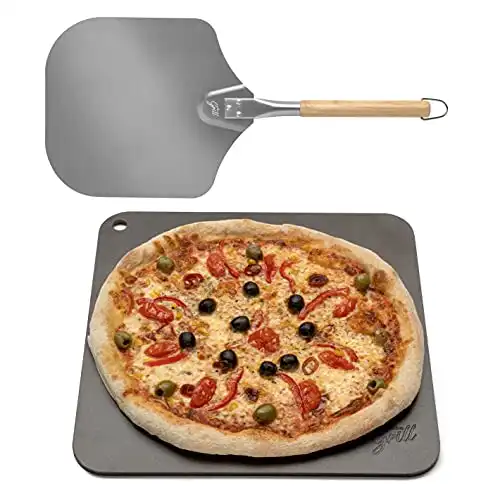
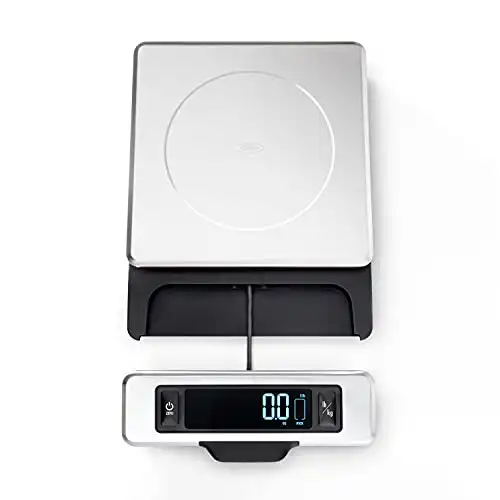
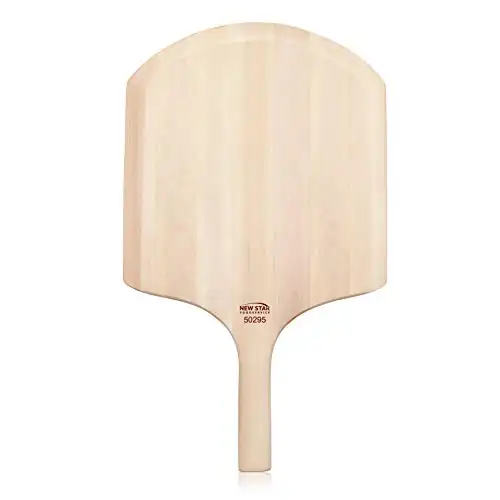
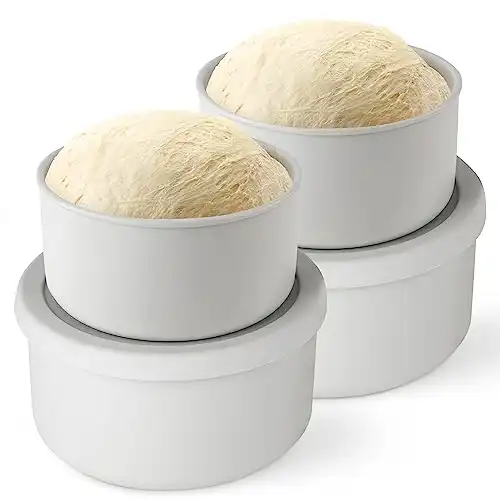
Easy to make and makes a great thin crust. I made 3 equal sized pizzas rather four. Next time I’ll make 4 because with 3 they were too big for my peel and stone. But exactly what I’ve been for with a thin crust. Can’t wait for the next pizza night. Thank you.
Hi Marie! Your video on stretching the pizza dough was incredibly helpful–thanks for including it in your post!! That part of the dough-making can be sort of intimidating, but the chef explained the process so well! I am Italian, and have grown up with all of the wonderful food (and fond memories of large family dinners), so cooking is definitely one of my true passions! I have always loved to bake (cookies, cakes, pies, breads) for my family, and learned from my mom how to make “the sauce” and many other wonderful Italian dishes. I have recently decided to venture into pasta-making (inspired by my maternal grandmother, who used to have me watch her make it by hand)! I love to find recipes for food which originated in the Puglia region of Italy, since that is where my ancestors are from. This past Christmas, I experimented with several different Italian sweets. We have always had strufoli during the holidays, and my husband and I love biscotti, but it was fun to try some new ones! I have always made my own pizza dough and sauce (cooked version), but would like to experiment with the no-cook versions. New York Pizza is my absolute favorite! I was born in New York, and my father’s family all resided in Brooklyn (had some of the best pizza ever there)! I’m looking forward to trying your dough and sauce recipe, and following your blog. It sounds like we have a lot in common!
Hi Cathy, yes, it sounds like we do! I hope you like the pizza dough…we also make biscotti and strufoli (around Christmas). I feel like the strufoli are becoming less and less common. One of these days I’ll put my recipe on the blog. My mom is one of those cooks who doesn’t measure anything so it’s hard to save her recipes.
I tried this recipe and it came out amazing. The only exception was that I don’t have a pizza stone so I placed the pizza base on the oiled cookie sheet ?
QUESTION: Any dfferences for making a calzone? (except the lower cooking temp) I’m going to try this and can’t WAIT to see how it does. I’ve been using a thin crust recipe that’s never had much flavor and not the right ‘bite’ so I’m hopeful.
I haven’t made calzone in a while, sorry! The dough would be the same though and yes, definitely lower cooking temperature and longer bake
HI! I tried making this dough recipe for the first time. I’m a little confused – it has been “rising” in the refrigerator for 2 days now and has not expanded at all in size. Is this normal? I followed the recipe exact – even weighed the flour as suggested! (or so I think – seems like I must have made a mistake somewhere…)
Any help/suggestions are welcome. Going to cook the pizza tonight anyway – we’ll see how it comes out!
Yup, this is completely normal!
Hi
This recipe looks great. I am anxious to try it. Can I ask that you break down each combination
of flours with cups and grams?
Example, you mention ounces and grams for the all purpose and bread flour, but only cups for the king arthur
or gold medal. I was confused because when I tried to convert the 6.5 cups of king arthur flour to grams by converting cups to ounces then ounces to grams the result was over 1400 grams which was much higher than that of the all purpose.
So can you please break each version down to grams.
Waiting to make this recipe.
Thank you
Brian
Hi Marie
Great looking recipe and will try this weekend. Thank you for this information.
But can you help me? I’m trying to figure out if I’m reading something wrong.
I’m a newbie 🙂
You put:
Flour , all purpose or bread, 28 oz (796 grams) (6.5 cups of King Arthur Brand or 6 cups of Gold Medal brand; see note)
Can you please break down the cups and grams for each version?
And also do you mean king Arthur bread or all purpose?
Same question for gold medal…bread or all purpose?
I got confused because I tried to figure the grams on the king Arthur at 6.5 cups, I converted
cups to ounces (52oz) then ounces to grams (1474gr), and came up with the king Arthur measurements
being a lot higher than the all purpose.
Please break it down in cups and grams per each type.
You’re the best,
Brian
Hi Brian, the weight stays the same, regardless of whether you use the bread or all purpose flour, so if you like using grams, use 796 grams of flour.
King Arthur all purpose flour has a high-ish protein level and so that it what I always use. I don’t bake with Gold Medal but it is also a very good flour. You can use the same weight (796 grams or 28 ounces) for either brand/type – does this help?
Absolutely delicious recipe! Came out perfect! I baked mine for 8 mins @ 500. Not sure how to freeze them just yet, but hopefully I come up with a decision soon! (Either freeze in their disc form, or form them as pizzas ready to go).
Great video instruction!
Hi Marie,
I likethe crisp coal fired pizza crust. Apparently it comes from an oven temp 800-900 degrees. Since a standard home oven can’t get to that temp is there a way to get the same result without the high heat?
Hi Bruce, I use a Blackstone oven when I make those type of pizzas (Neapolitan pizza). The temperature goes up very quickly using the Blackstone. They are comparable in price and size to many BBQ grills, and I absolutely looooove mine! If you make a lot of pizzas (or even weekly), they are well worth the investment. Otherwise, you may want to play around with heating a cast iron pan on the stove top and cook your pizzas directly on the stovetop followed by a few minutes under the broiler or vice versa. I’ve seen this done and it looks interesting…
My husband said this was the best pizza he has EVER had and I agree. I love that the recipe makes 4 pizzas and I cant wait to bake the other two soon. I never eat crust, but the dogs were out of luck with this one.
ahaha! I’m glad to hear it!
Absolutely fantastic, I tried this the other day and it turned out better than I had possibly anticipated. I used a slight variant of the dough recipe (more yeast, a little less salt and oil), as well as bottled water to avoid any off tastes that may come from municipal treatment processes. This was at least as good as the best local places around me, and 1000 times better than any of the big chains. Thanks especially for including the video for spreading the dough. I followed that method and it worked exactly like it did for the guy in the video.
This is the best pizza crust that I have ever made, chewy and thin.My family absolutely loves it! Almost never order pizza out anymore. Thanks so much for posting recipe and tips!
Best pizza dough recipe I’ve made so far. I used active dry yeast instead, came out well.
Amazing dough! This recipe makes the best pizza I’ve had outside Little Italy (and my Nonna’s kitchen) and was so fast and simple. I made 2 batches of dough, made sauce from an arrabiata I had jarred a while back, and topped the pizzas with different meats and veggies. Absolute Super Bowl hit! Thanks, Marie. I’m loving the other recipes on your site….